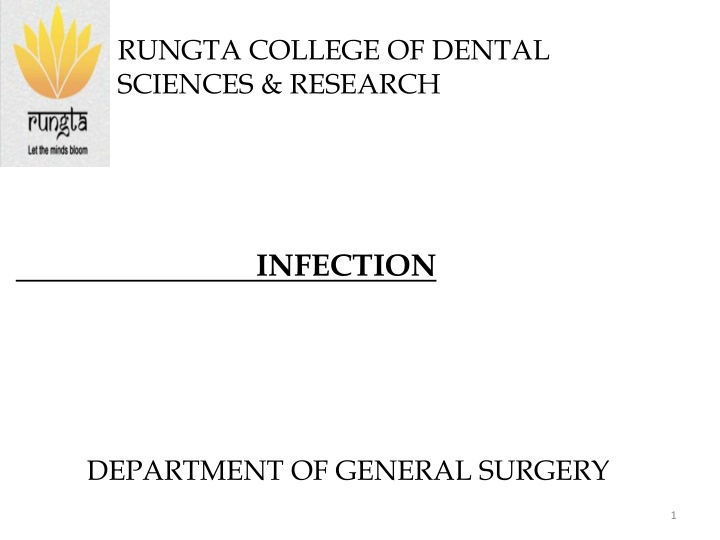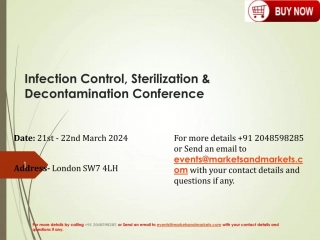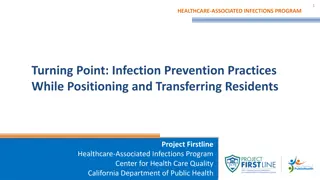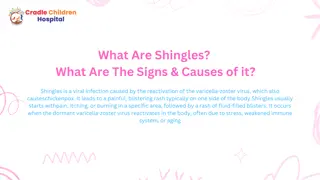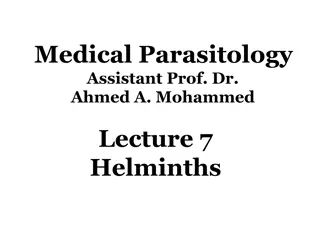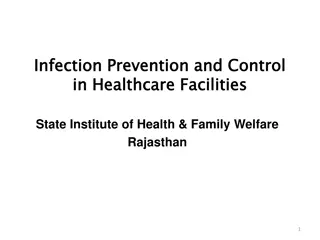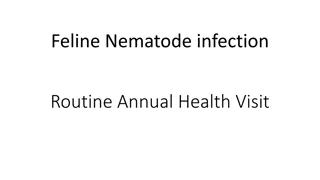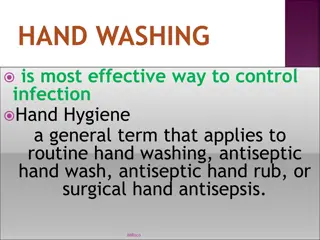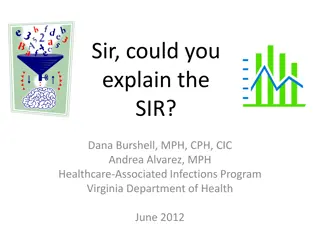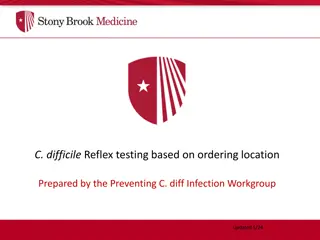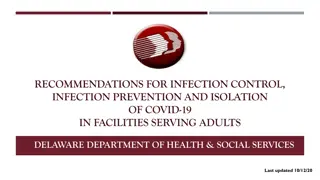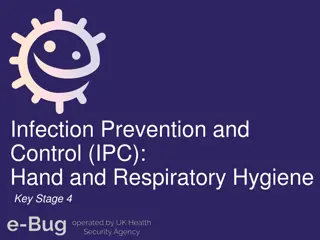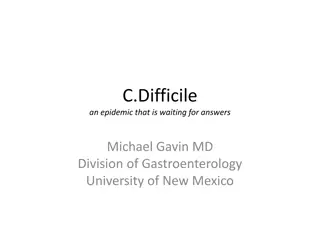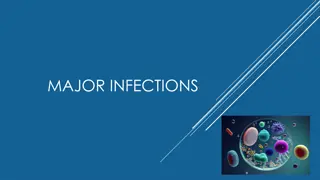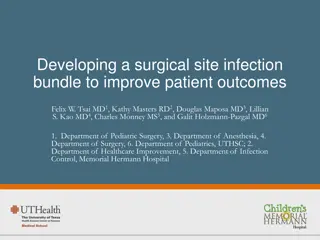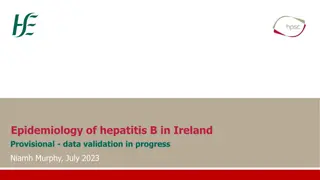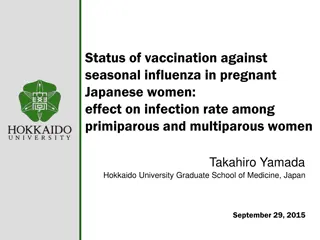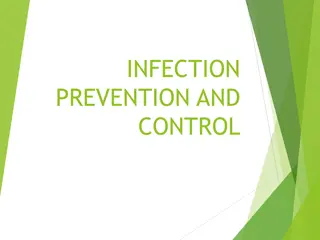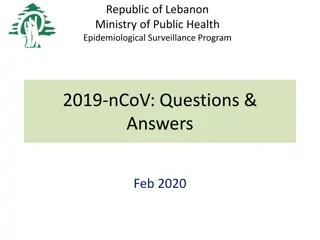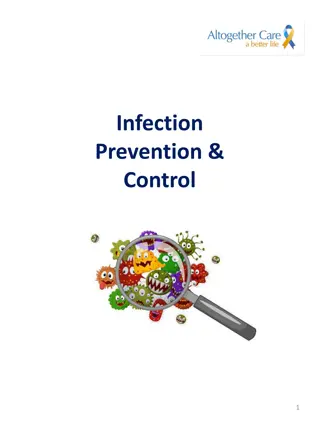INFECTION
Offering comprehensive dental education and research opportunities at Rungta College of Dental Sciences & Research, the infection department of general surgery excels in innovative treatments and advancements in the field. Students and professionals alike benefit from a dynamic learning environment focused on cutting-edge practices and hands-on experiences.
Uploaded on Feb 15, 2025 | 1 Views
Download Presentation

Please find below an Image/Link to download the presentation.
The content on the website is provided AS IS for your information and personal use only. It may not be sold, licensed, or shared on other websites without obtaining consent from the author.If you encounter any issues during the download, it is possible that the publisher has removed the file from their server.
You are allowed to download the files provided on this website for personal or commercial use, subject to the condition that they are used lawfully. All files are the property of their respective owners.
The content on the website is provided AS IS for your information and personal use only. It may not be sold, licensed, or shared on other websites without obtaining consent from the author.
E N D
Presentation Transcript
RUNGTA COLLEGE OF DENTAL SCIENCES & RESEARCH INFECTION DEPARTMENT OF GENERAL SURGERY 1
INFECTION AND INFECTIOUS DISEASES
Specific learning Objectives At the end of this presentation the learner is expected to know ; Core areas* Domain ** Category # Cognitive Must Know Definition of Infection Cognitive Must Know Actinomycosis Madura Foot Leprosy HIV and AIDS Syphilis Cognitive Must Know Cognitive Must Know Cognitive Must K now 3 Cognitive Must Know
Table of Content Definition of Infection and Infectious diseases. Actinomycosis Madura Foot Leprosy HIV and AIDS Syphilis 4
What is infection- - It is the entry of an micro-organism in the body tissue and causing pathological changes in body tissue and on its functioning. Signs /Symptoms- When a micro-organism enters the tissue and multiply there,it causes some pathological changes.These are manifested as- fever,body pain,giddiness,local swelling and pain etc.
INFECTIOUS DISEASES DEFINITION- Infectious disease, also known as transmissible disease or communicable disease.In this ,the infection can be passed on from an ill person to a healthy person directly or by indirect means like vector, water or food etc.
Few related terms- *Subclinical infection *Latent infection *Opportunistic infection *Contagious infection
Mode of Transmission 1.By droplet 2.Feco-oral route 3.Sexual transmission 4.Direct contact transmission 5.Vertical transmission 6.Iatrogenic transmission 7.Vector borne transmission
EPIDEMIOLOGY Definition- A branch of medical science that deals with the study of incidence, distribution, and control of disease in a population in a given time period. Endemic ,Epidemic, Pandemic & sporodic *Endemic: a disease that exists permanently in a particular region or population. Malaria is a constant worry in parts Africa. *Epidemic: A sudden outbreak of disease that attacks many peoples at about the same time and may spread through one or several communities. *Pandemic: When an epidemic spreads throughout the world. *Sporadic- Occasionally occuring disease in some parts of a country.
Actinomycosis is a subacute-to-chronic Bacterial infection caused by filamentous, gram positive,non acid fast anaerobic bacteria. It is charactrized by contiguous spread,suppurative and granulomatous inflamation and formation of multiple abscess and sinus tracts that may discharge sulphur granules.
Actinomycosis is caused by a fungal like bacterium called-Actinomyces Israelii. It is an anerobic, gram +ve organism. Its filamentous and branching appearance gives a name Ray Fungus-because of it s Sun appearance. This organism is normally present in oral cavity,crypts of tonsil and in dental cavities. These organism become pathogenic in presence of trauma or ulceration.
Pathogenesis- * organism enter through deeper plane of tissue and produce sub acute inflammation with induration and nodule formation.These nodules are multiple and ultimately after necrosis,they start discharging muco-purulant secretion.And thus multiple discharging sinus are seen on the surface. * The discharge contains yellow colored sulphur granules,actually these are clusters of bacteria.
Common sites of actinomycosis -Clinically -as per the body part affected- 3 types of actinomycosis described- 1.Cervico-facial actinomycosis. 2.Actinomycosis of Thorax & lung. 3.Actinomycosis of Right iliac fossa & liver.
facio-cervical Actinomycosis Poor oral hygiene ,bad carries teeth. The organism produce a subacute inflammation for many months to years and produce lumpy jaw. Later on cheek,mandible,salivary glands are involved resulting in supuration and formation of multiple discharging sinuses. The discharge contains sulphur granules. Lymph nodes are not involved
Cervicofacial Actinomycosis Cervicofacial Actinomycosis Cervicofacial Actinomycosis Cervicofacial Actinomycosis
ACTINOMYCOSIS OF THORAX & LUNG * It is common in children. *Lungs and pleura get affected by direct spread from inhalation or aspiration. *Empyema develops. * Later on,nodules appear on chest wall leading to discharging sinues. (20% cases)
Actinomycosis of Rt.iliac fossa *It presemt as a mass in abdomen over Rt.iliac fossa with discharging sinus. * Usually seen after appendisectomy.From the Intestine the organism travel to the operation site and produces subacute inflammation. Gradually the area becomes indurated and mass appear there.Later on this mass involves the abdominal wall and produces discharging sinuses over the skin surface. * Liver is infected through portal vein.
Investigation- 1.Pus examination for filamentous organism. 2.Gram s staining 3.Cultured in brain heart infusion agar. D/D- 1.Chronic osteomylitis 2.Carcinoma in situ 3.Tuberculous disease.
Treatment IT IS A LOW GRADE CHRONIC DISEASE AND DIFFICULT TO ERADICATE. 1.Inj.cry.penicillin 10 lac.unit once a day for 6-12 weeks or even months. 2.Tetracycline and lincomycin are the other alternative. 3.Actinomycosis of rt. Iliac fossa may require rt. Hemicolectomy. 4.Surgical debridement of sinuses may be required. 5.Anti-fungal drugs and dapsone/iodides have been tried. *************
Madura foot is a chronic granulomatous disease Of foot causing multiple discharging sinuses in the foot. It was first detected in Madurai by Mr.Gill. It is common in India(TN) and Africa. Organism- Nocardia Madurae Nocardia Brasiliensis Actinomyces Israilii.
Treatment- 1.Antifungal drugs. 2.Antibiotics. 3.Treatment of secondary infection 4.Sometime amputation,if bones are grossly involved. *****
Leposy is caused by *Mycobacterium Leprae it is a acid fast bacillus. *Poverty , poor hygiene and over- population help in spreading the disease. *Nasal secretions, active ulcer and sweat also contains the bacilli. * Incubation period is 2 to 5 years. * The disease mainly affect the skin,upper respiratory tract and nerves.
Types of leprosy- 1.Tuberculoid-(in patient with good immunity.) 2.Lepromatous-(in patient with poor immunity) 3.Borderline- a)B.tuberculoid b)B.lepromatous. Treatment- For lepromatous- 3 drug regime is followed 1.Dapsone 100mg/day 2.Clofazimine 50mg/day and 300mg once a month. 3.Rifampicin 600mg-once a month The treatment may continue for 2 year till the skin smear test is negative. For tuberculoid- 1.Dapsone 100 mg/day 2. Rifampicin 600mg once a month . Treatment is given for 6 months
Role of surgery- Surgery is required for correction of deformities which are due to disease directly. The deformities are seen on FACE,HAND &FOOT. Face may require plastic reconstrction Prosthesis for nose,tarsorrhaphy,muscle flap to prevent keratitis etc. Claw hand- Paul Brand s procedure or Bunnel s procedure. Foot drop-OBER s and BARR S PROCEDURE
HIV HIV And And AIDS AIDS
HIV is a virus that attacks the immune system and which ultimately leads to development of Aids. Aids is a sequelae of HIV infection
HIV AND PATHOGENESIS HIV is a virus that attacks the immune system, which is our body s natural defense against illness. The virus destroys a type of white blood cell in the immune system called a T-helper cell. T-helper cells are also referred to as CD4 cells.These cells are responsible for initiating the immune response and antibody formation. Functions of T-helper cells- 1.It induce and controls the normal immune response. 2.It activates the B cells to produce antibodies in response to any infection. 3.Activated CD 4 cell stimulates the CD8,macrophages,TNF and Natural Killer cells. 4.They memorizes the injuring agent for future action. THUS HIV COMPLETELY SUPPRESSES IMMUNE SYSTEM BY DIRECTLY SUPPRESSING THE T CELLS AND INDIRECTLY BY SUPPRESSING B CELLS.
Pathogenesis Glycoprotein of HIV binds with the surface molecule CD-4 of T-lymphocyte and make them ineffective. As CD4 cell induces and controls the normal immune response.Thus HIV suppresses the immune system by suppressing the T-cell and indirectly by suppressing the B- cells.All these result in low / no body immunity.This state of body allows the opportunistic micro-organism to grow and cause illnesses.
If HIV is left untreated, with progressive poor body defense, the other infections will flourish and patient will have symptoms of those infection. This is onset of AIDS. It may take up to 10 or 15 years for the immune system to be so severely damaged.
HIV and AIDS History. Scientists believe that HIV originally came from a virus particular to chimpanzees in West Africa during the 1930s, and originally transmitted to humans through the transfer of blood through hunting. Over the decades, the virus spread through Africa, and to other parts of the world.
History :: 1. 1983: discovery of the virus. First case of AIDS detected in UK. 2. Development of an antibody test. Types :: High and low variety of virus. There are two types of HIV: HIV-1 and HIV-2. HIV-1 is more virulent, is more easily transmitted and is the cause of the vast majority of HIV infections globally. Mode of transmission-1. Sexual intercourse Vaginal or Anal. 2. Needle pricks-using unsterilised needles for injection,iv drug abusers. 3.Mother &breastmilk. to child-plecenta,vaginal secretion 4. Blood transfusion , organ transplantations etc.
Anti-HIV antibody- Usually it appears about 3 weeks to 3 months interval after the infection.This is very weak in action and remains through out the infection. Window period- As the antibodies appear about 3 months after the infection,so any test for confirming diagnosis during these 3 months may be negative.Patient may be having infection but test are negative during this period.So this period is called window period.Therefore ,the screening test should be repeated after 3 months before concluding negative in a patient.
TEST FOR HIV 1. ELISA test [screening test] 2. Western blot test [diagnostic test] 3. Polimerase chain reaction [PCR] 4. HIV antibody detection test. 5. CD4 count-(Normal value->500/mm3.) 6. Viremia quantification.
GENERAL FEATURES IN AIDS 1. Weight loss 2. Fever more than 1 month 3. Diarrhea more than 1 month. 4. Lymphadenopathy. 5. Dental infection, gingivitis, oral condidiasis. 6. Skin rashes, dermetitis, fungal infection 7. Opportunistic infection, TB, cold abscess etc.
OTHER COMPLICATION 1. Tumours- Kaposi sarcoma Lymphomas Lung cancer, Testicular tumours. 2. Pulmonary manifestation- Pneumonia,Tuberculosis,fungal inf. 3. GI problems GIT infection,Hepatitis,Abdominal TB. 4. CNS-encephelitis,meningitis,neuropathies. 5. AIDS anus syndrome- Anal warts,diarrhoea, Incontinence.
Kaposis sarcoma
